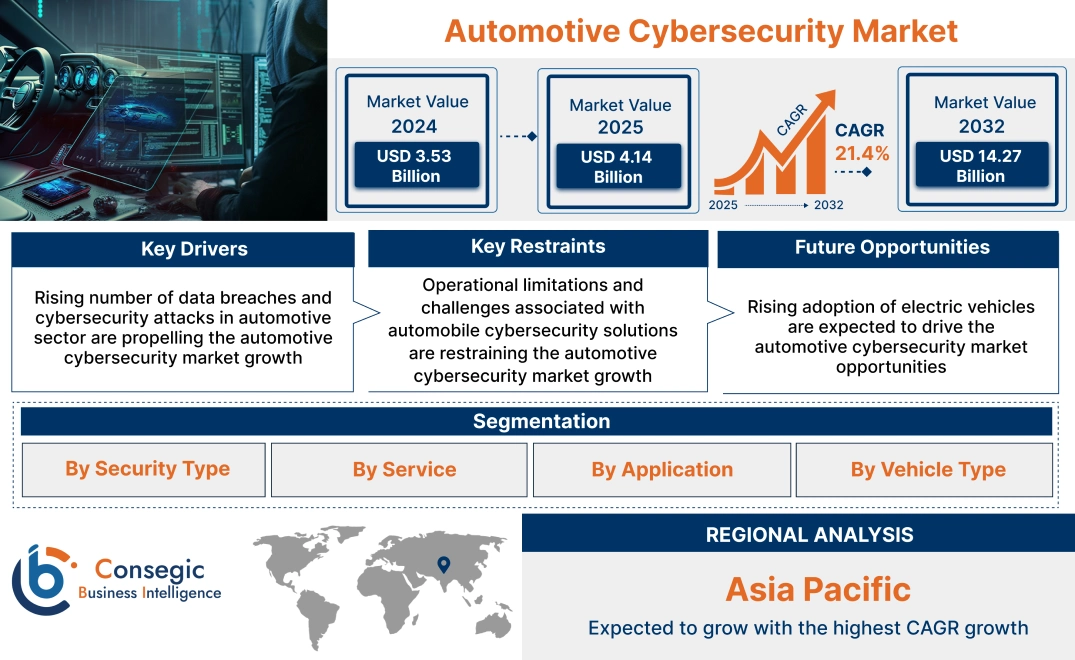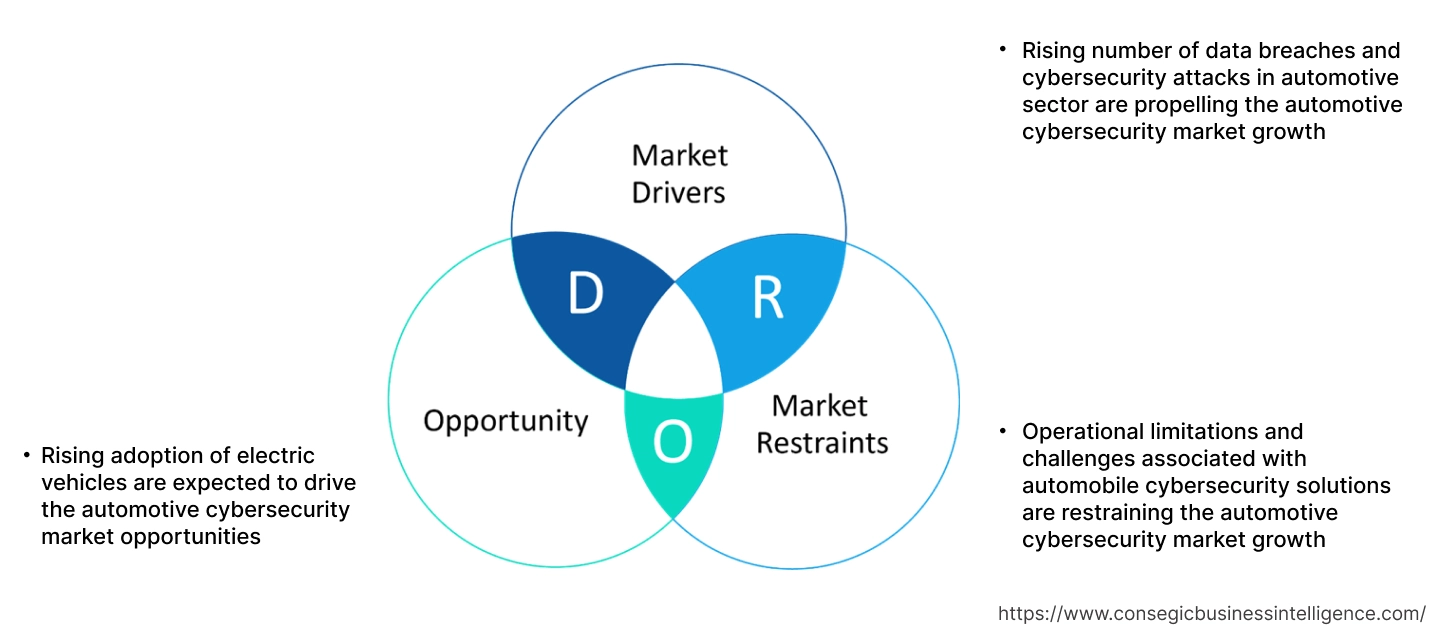- Summary
- Table Of Content
- Methodology
Automotive Cybersecurity Market Size:
Automotive Cybersecurity Market size is estimated to reach over USD 14.27 Billion by 2032 from a value of USD 3.53 Billion in 2024 and is projected to grow by USD 4.14 Billion in 2025, growing at a CAGR of 21.4% from 2025 to 2032.
Automotive Cybersecurity Market Scope & Overview:
Automotive cybersecurity involves the protection of automotive electronic systems, control algorithms, communication networks, users, software, and underlying data from malicious attacks, unauthorized access, damage, or manipulation. Moreover, automotive cybersecurity solutions are primarily implemented for protecting connected vehicles and its on-board systems from digital threats while ensuring secure and safe transportation for vehicles and their data. Moreover, automotive OEMs (original equipment manufacturers) must provide a robust cybersecurity framework that fulfills evolving automotive regulations for competing in the new automotive landscape and ensuring trust in the ecosystem.
Key Drivers:
Rising number of data breaches and cybersecurity attacks in automotive sector are propelling the automotive cybersecurity market growth
The automotive sector is transforming significantly as vehicles are increasingly connected to everything in order to support innovations such as advanced driver assistance systems (ADAS), autonomous driving, shared mobility, electric vehicles (EVs), and others. As the ecosystem becomes increasingly connected, the advent of connected vehicles leads to increment in potential attack points while exposing new vulnerabilities that hackers may exploit for threatening the vehicle safety, car data integrity, and users' privacy. As a result, the rising number of data breaches and cybersecurity attacks in automotive sector are increasing the need for advanced automobile cybersecurity solutions, in turn driving the market.
- For instance, in 2024, Volkswagen Group faced a significant data breach, which exposed sensitive information of approximately 800,000 EV owners across its several brands such as Volkswagen, Seat, Audi, and Skoda. The data breach occurred due to a misconfigured Amazon cloud storage system, which was managed by Volkswagen’s software subsidiary, Cariad, leading to online accessibility of personal and location data for several months.
Hence, the rising number of data breaches and cybersecurity attacks in automotive sector are increasing the need for advanced security solutions, in turn proliferating the automotive cybersecurity market size.
Key Restraints:
Operational limitations and challenges associated with automobile cybersecurity solutions are restraining the automotive cybersecurity market growth
The implementation of automotive cybersecurity solution is often associated with certain operational limitations and challenges, which are among the key factors restraining the market. For instance, the automotive sector has one of the most complex and largest supply chains. This includes the frequent integration of third-party components, software, applications and communications protocols, which may generate key cybersecurity weaknesses and quality-control issues. Moreover, cybersecurity protection in automotive sector is difficult and complex with the involvement of several players, each generating their own patch specifications and complying with numerous standards.
Additionally, the solutions for automobile cybersecurity depend on the specifications provided by the automotive OEMs. These solutions usually vary due to the utilization of different platforms in the same vehicle model, different features in the vehicle, and differences in the electronic architecture. As a result, automobile cybersecurity solution providers are highly prone to facing integration risks and challenges while dealing with vulnerabilities and threats of a vehicle. Therefore, the aforementioned factors are hindering the automotive cybersecurity market expansion.
Future Opportunities:
Rising adoption of electric vehicles are expected to drive the automotive cybersecurity market opportunities
Factors including the prevalence of stringent automotive emission regulations, rising consumer preference for sustainable transportation, along with availability of subsidies and tax rebates are leading to significant adoption of electric vehicles (EVs). Moreover, modern EVs utilize several interconnected electronic control units and sensors that control critical functions such as charging, battery management, powertrain control, and advanced driver assistance systems (ADAS). These systems also communicate with each other and with external devices, including charging stations and other vehicles, through wired and wireless networks, which may create potential risks for cyberattacks. This is further driving the need for automobile cybersecurity solutions.
- For instance, according to International Energy Agency (IEA), the overall sales of electric car reached approximately 14 million in 2023, among which China, Europe and United States accounted for 95% of the total sales.
Hence, as per the analysis, the rising adoption of electric vehicles is projected to increase the demand for automobile cybersecurity solutions for integration in modern EVs, thereby, driving the automotive cybersecurity market opportunities during the forecast period.
Automotive Cybersecurity Market Segmental Analysis :
By Security Type:
Based on security type, the market is segmented into endpoint, application, and wireless network.
Trends in the security type:
- Increasing trend in adoption of automotive wireless network security solutions for facilitating improved data integrity and confidentiality along with protection against unauthorized data access.
- Rising utilization of automotive application security solutions for minimizing vulnerabilities and improving vehicle security.
The wireless network segment accounted for the largest revenue in the overall automotive cybersecurity market share in 2024.
- Wireless network security in automotive sector includes protection of vehicle communication systems from unauthorized access and cyberattacks over various wireless channels, including vehicle-to-infrastructure (V2I), vehicle-to-vehicle (V2V), and telematics services among others.
- Wireless network security also includes encrypting data transmissions, securing communication protocols, and ensuring that the wireless networks used by vehicles are resistant against cyberattacks.
- Moreover, automotive wireless network security offers several benefits such as data integrity and confidentiality, protection against unauthorized access, improved communication safety, and others.
- Therefore, the above benefits of automotive wireless network security solutions are increasing its adoption in modern vehicles, in turn driving the automotive cybersecurity market trends.
The application segment is anticipated to register significant CAGR growth during the forecast period.
- Application security primarily focuses on securing the software applications that run on vehicle systems and connected platforms.
- Automotive application security ensures the integrity of software, while preventing vulnerabilities in third-party applications and maintaining robust security protocols during software maintenance and updates.
- For instance, in August 2024, Kondukto Inc., an application security orchestration and management platform provider, announced partnership with ETAS GmbH, in order to deliver an integrated security orchestration solution for software-defined vehicles for protection against unauthorized access and cyberattacks on automobile systems.
- According to the automotive cybersecurity market analysis, the increasing developments related to automotive application security solutions are projected to boost the market during the forecast period.
By Service:
Based on service, the market is segmented into in-vehicle services and external cloud services.
Trends in the service:
- Increasing advancements associated with in-vehicle automobile cybersecurity solutions are driving the segment.
- Rising trend in adoption of in-vehicle automobile cybersecurity solutions for facilitating enhanced safety and data protection, particularly among connected vehicles.
In-vehicle services segment accounted for a significant revenue in the total automotive cybersecurity market in 2024, and it is anticipated to register substantial CAGR growth during the forecast period.
- In-vehicle services including security solutions that are implemented for protecting the electronic systems of a vehicle from unauthorized access, and other cybersecurity threats/attacks.
- In-vehicle services cover a range of security measures that are designed for protecting data communications, onboard software, and ensuring the integrity of critical functions of the vehicle.
- For instance, in October 2024, Panasonic Automotive Systems Co., Ltd. expanded its series of VERZEUSE, which is an automotive cyber security innovation developed for accommodating security requirements in each phase of the entire vehicle lifecycle, ranging from the development to operation. VERZEUSE is also capable of protecting against cyberattacks on in-vehicle software.
- Therefore, increasing advancements associated with in-vehicle automobile cybersecurity solutions are driving the automotive cybersecurity market trends.
By Application:
Based on application, the market is segmented into ADAS & safety system, infotainment, body electronics, powertrain, and telematics.
Trends in the application:
- Factors including increasing automotive production along with rising demand for improved safety, convenience, and accessible navigation & entertainment solutions in automobiles are propelling the growth of the infotainment segment.
- Factors including growing concerns associated with vehicle safety, and rising government initiative for integration of ADAS in modern vehicles for enhanced road safety are crucial aspects driving the ADAS & safety system segment.
Infotainment segment accounted for a significant revenue share in the overall market in 2024.
- Infotainment system consists of components that provide a range of comfort, entertainment, and navigation functions.
- Infotainment system include multimedia, radio, navigation, and connectivity functions Infotainment system provides drivers and passengers with information, entertainment, and navigation services, by integrating video, audio, and data applications into the vehicle environment.
- Moreover, infotainment systems are usually connected to various networks. Automobile cybersecurity solutions are utilized for ensuring that the infotainment system’s software and firmware are authenticated while preventing any unauthorized access and malware deployment.
- Thus, increasing adoption of automobile cybersecurity solutions in infotainment system for preventing unauthorized access and malware deployment are accelerating the automotive cybersecurity market size.
ADAS & safety system is anticipated to register substantial CAGR growth during the forecast period.
- Advanced driver-assistance system (ADAS) & safety system are primarily integrated in modern vehicles for assisting drivers with safe operation of a vehicle.
- Moreover, ADAS & safety systems utilize automated technology involving sensors and cameras for detecting nearby obstacles or driver errors, and responding accordingly to avoid an accident.
- Additionally, the integration of advanced driver assistance systems in modern vehicle facilitate several vehicle functionalities such as adaptive cruise control, intelligent park assistance, rollover stability control, lane departure warning, blind spot detection, and automatic emergency braking among others.
- For instance, in April 2022, Honda Cars India Limited launched its new hybrid electric vehicle, Honda City eHEV. The Honda City eHEV is also integrated with ADAS technology to provide an enhanced driving experience.
- Thus, the rising integration of ADAS and safety systems in modern vehicles is projected to increase the adoption of automobile cybersecurity solutions, thereby, driving the market during the forecast period.
By Vehicle Type:
Based on the vehicle type, the market is segmented into passenger car, light commercial vehicle, and heavy commercial vehicle.
Trends in the vehicle type:
- Factors including the rising disposable income, growing popularity of luxury cars, and progressions in autonomous driving systems are key aspects propelling the passenger cars segment.
- Factors including the rising sales of heavy-duty vehicles, growing investments in commercial vehicles, and increasing need for economical modes of transportation and logistics are primary determinants for driving the commercial vehicles
Passenger car segment accounted for the largest revenue share of 54.88% in the total automotive cybersecurity market share in 2024, and it is anticipated to register substantial CAGR growth during the forecast period.
- Automobile cybersecurity solutions are often used in passenger cars for protection of vehicle communication systems from unauthorized access and cyberattacks over various wireless channels, including vehicle-to-infrastructure (V2I), vehicle-to-vehicle (V2V), and telematics services among others.
- Automobile cybersecurity solutions are also used for securing the software applications that run on passenger car systems and connected platforms.
- For instance, according to the International Organization of Motor Vehicle Manufacturers, the total passenger car production in Europe reached up to 15.45 million in 2023, representing an increase of nearly 13% from 13.73 million in 2022.
- According to the analysis, the rising production of passenger cars is propelling the need for automobile cybersecurity solutions, in turn boosting the market.
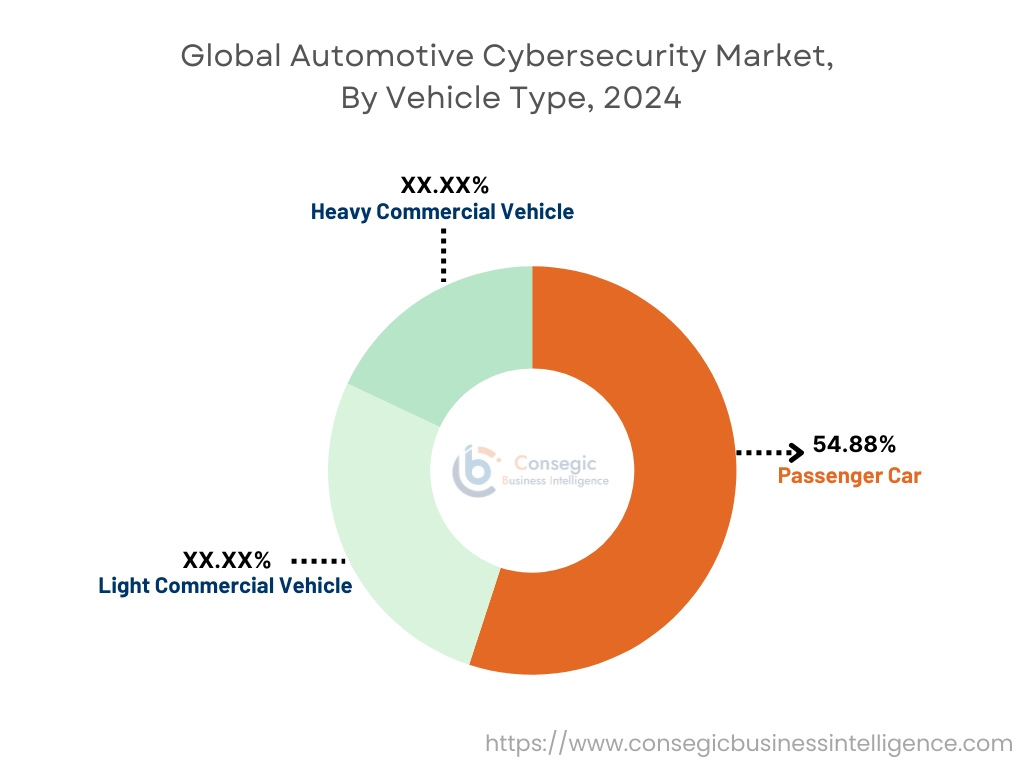
Regional Analysis:
The regions covered are North America, Europe, Asia Pacific, Middle East and Africa, and Latin America.
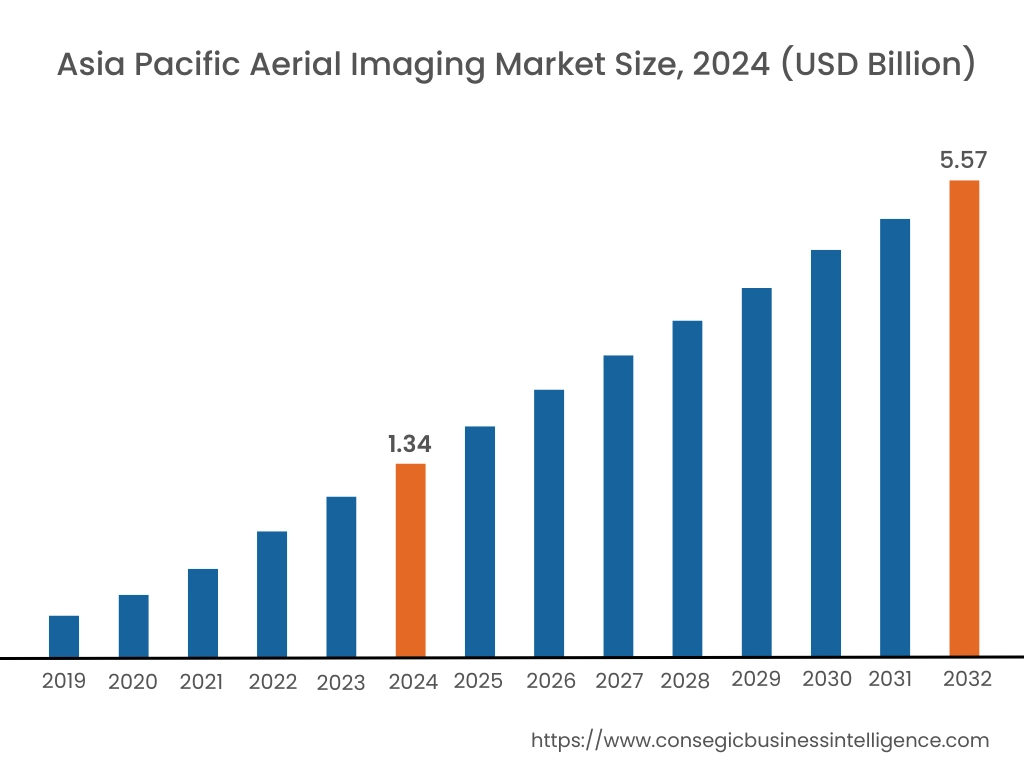
Asia Pacific region was valued at USD 1.34 Billion in 2024. Moreover, it is projected to grow by USD 1.58 Billion in 2025 and reach over USD 5.57 Billion by 2032. Out of this, China accounted for the maximum revenue share of 29.56%. As per the automotive cybersecurity market analysis, the adoption of automobile cybersecurity solutions in the Asia-Pacific region is primarily driven by increasing government investments in automotive industry, rising automobile production, and increasing adoption of electric vehicles. Moreover, the rising advancements associated with passenger cars and increasing integration of advanced driver assistance system in modern vehicles are further accelerating the automotive cybersecurity market expansion.
- For instance, according to the Society of Indian Automobile Manufacturers (SIAM), the total production of passenger vehicles in India reached 49,01,844 units during FY 2023-24, witnessing an increase of 7% in comparison to FY 2022-23. The aforementioned factors are propelling the market demand in the Asia-Pacific region.
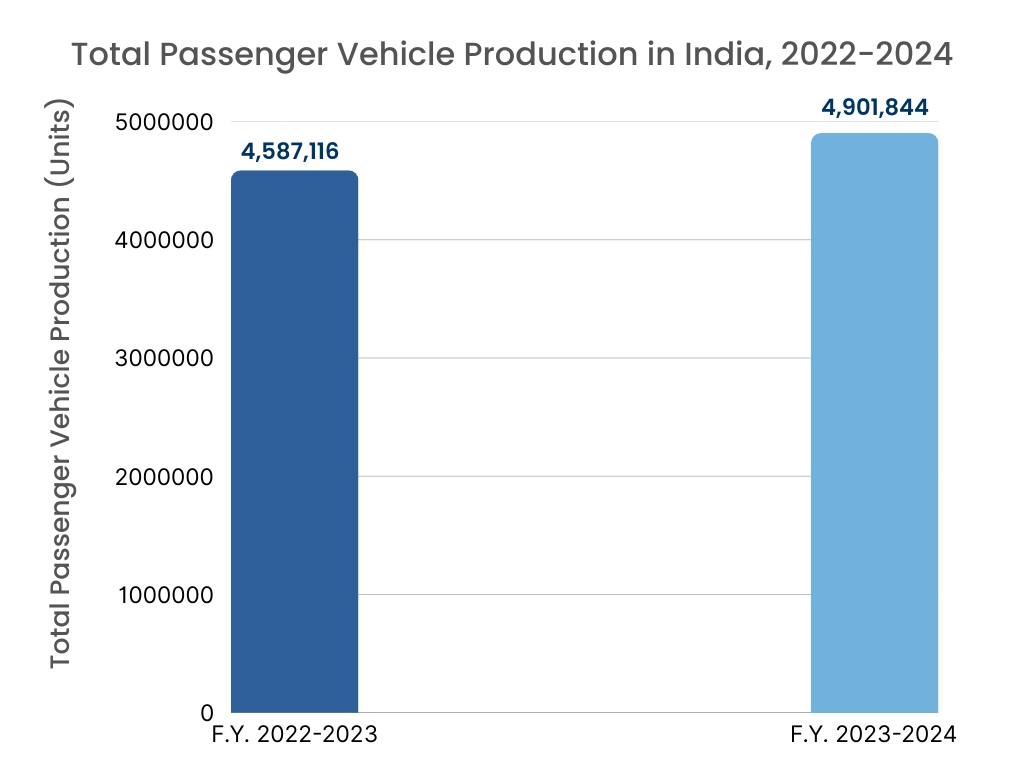
North America is estimated to reach over USD 3.86 Billion by 2032 from a value of USD 0.96 Billion in 2024 and is projected to grow by USD 1.13 Billion in 2025. In North America, the growth of automotive cybersecurity industry is driven by increasing production of automobiles and increasing adoption of electric vehicles in the region. Similarly, rising advancements related to autonomous vehicles and growing number of connected vehicles are contributing to the automotive cybersecurity market demand.
- For instance, in October 2024, Tesla introduced the Cybercab, the company’s robotaxi, and also announced plans to commence autonomous driving of its Model 3 and Model Y cars in Texas and California states in the U.S in 2025. The above factors are projected to drive the market in North America during the forecast period.
Additionally, the regional analysis depicts that increasing vehicle production, advent of electro mobility, favorable government measures for integration of advanced driver assistance system in modern vehicles, and rising need for advanced automotive security solutions are driving the automotive cybersecurity market demand in Europe. Further, as per the market analysis, the market demand in Latin America, Middle East, and African regions is expected to grow at a substantial rate due to several factors such as growing automotive sector, increasing investments in electric vehicles, and rising need for enhanced cybersecurity solutions for automobiles among others.
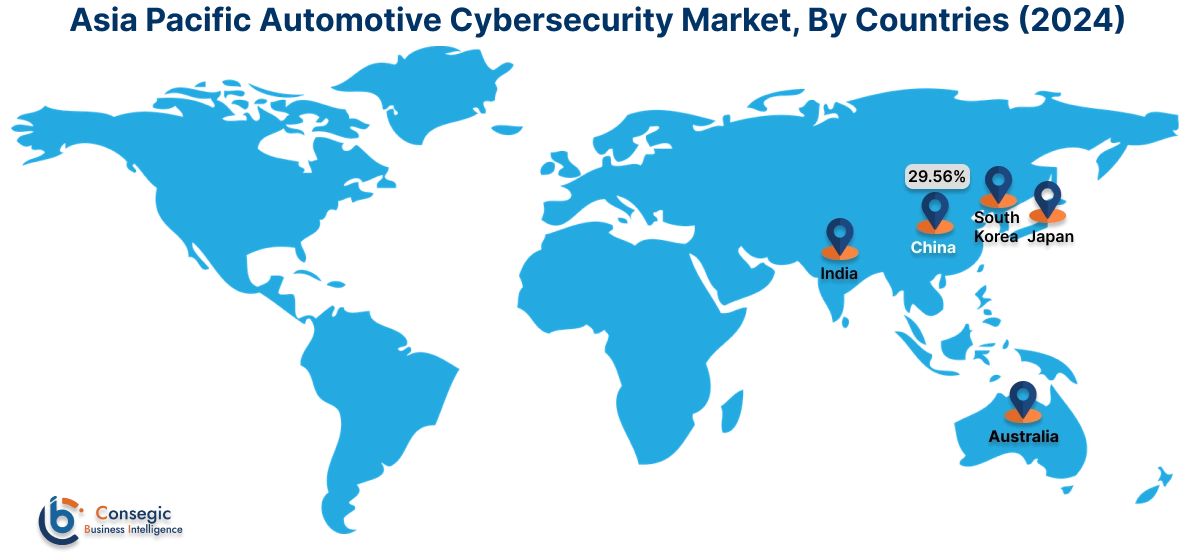
Top Key Players & Market Share Insights:
The global automotive cybersecurity market is highly competitive with major players providing solutions to the national and international markets. Key players are adopting several strategies in research and development (R&D), product innovation, and end-user launches to hold a strong position in the automotive cybersecurity market. Key players in the automotive cybersecurity industry include-
- Vector Informatik GmbH (Germany)
- VicOne Inc. (Japan)
- Broadcom Inc. (U.S)
- Denso Corporation (Japan)
- Honeywell International Inc. (U.S)
- Sonatus Inc. (U.S)
- Guard Knox Cyber-Technologies Ltd. (Israel)
- Sheelds (Israel)
- NXP Semiconductors N.V. (Netherlands)
- Harman International (U.S)
Recent Industry Developments :
Product Launch:
- In October 2024, Panasonic Automotive Systems Co., Ltd. expanded its series of VERZEUSE, which is an automotive cyber security solution designed for accommodating security requirements in each phase of the entire vehicle lifecycle.
Partnerships & Collaborations:
- In November 2024, VVDN Technologies partnered with SecureThings.ai Pvt Ltd for providing robust cybersecurity solution for automotive, and other sectors, with a key focus on the connected vehicle ecosystem.
Automotive Cybersecurity Market Report Insights:
| Report Attributes | Report Details |
| Study Timeline | 2019-2032 |
| Market Size in 2032 | USD 14.27 Billion |
| CAGR (2025-2032) | 21.4% |
| By Security Type |
|
| By Service |
|
| By Application |
|
| By Vehicle Type |
|
| By Region |
|
| Key Players |
|
| North America | U.S. Canada Mexico |
| Europe | U.K. Germany France Spain Italy Russia Benelux Rest of Europe |
| APAC | China South Korea Japan India Australia ASEAN Rest of Asia-Pacific |
| Middle East and Africa | GCC Turkey South Africa Rest of MEA |
| LATAM | Brazil Argentina Chile Rest of LATAM |
| Report Coverage |
|
Key Questions Answered in the Report
How big is the automotive cybersecurity market? +
The automotive cybersecurity market was valued at USD 3.53 Billion in 2024 and is projected to grow to USD 14.27 Billion by 2032.
Which is the fastest-growing region in the automotive cybersecurity market? +
Asia-Pacific is the region experiencing the most rapid growth in the automotive cybersecurity market.
What specific segmentation details are covered in the automotive cybersecurity report? +
The automotive cybersecurity report includes specific segmentation details for security type, service, application, vehicle type, and region.
Who are the major players in the automotive cybersecurity market? +
The key participants in the automotive cybersecurity market are Vector Informatik GmbH (Germany), VicOne Inc. (Japan), Sonatus Inc. (U.S), Guard Knox Cyber-Technologies Ltd. (Israel), Sheelds (Israel), NXP Semiconductors N.V. (Netherlands), Harman International (U.S), Broadcom Inc. (U.S), Denso Corporation (Japan), Honeywell International Inc. (U.S), and others.
